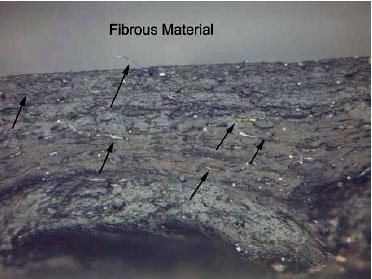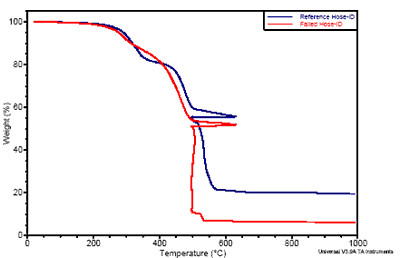A quick inspection by Element Materials Technology of the date codes on the failed oil hoses revealed that all of the failures were isolated to an individual production lot. The failed hoses were sectioned and multiple tears were evident within the inner tube. The hose exhibited good tensile strength of the outer jacket material, but poor integrity of the inner tube. A microscopic inspection revealed a strange morphology on the inner tube tear surfaces, with a high concentration of fibrous material within the rubber compound.

Figure 1. Fibrous material contamination was evident within the inner tube material of the failed oil hose.
Analytical testing using Fourier transform infrared spectroscopy (FTIR) and thermogravimetric analysis (TGA) showed that the inner tube of the failed sample had a significantly different rubber formulation relative to a control sample. While the failed sample contained chlorinated polyethylene, it was contaminated with nitrile rubber (NBR) and cellulosic-based fibers.

Figure 2. TGA curves for a failed hose sample and a control sample.
Conclusion
The testing carried out by Element Materials Technology showed that the NBR and cellulosic fibers were limited to the inner tube material and not the outer jacket of the hose.
After contacting the manufacturer of the hose, it was determined that the hose extruding equipment had not been fully purged prior to fabricating the chlorinated polyethylene oil hose. A previous production run had utilized an NBR compound containing cellulosic fibers.
Follow-up testing was conducted in order to determine the extent of contaminated hoses.
Significant cost and time was saved by determining that the failures were isolated to a single production run, with only approximately 100 feet of the lot contaminated. Overall, the NBR was not properly cross linked, and represented the weakest link in the chlorinated polyethylene hose.
Fatigue and Fracture In Environment - Extended Version
Video Credit: Element Materials Technology

This information has been sourced, reviewed and adapted from materials provided by Element Materials Technology.
For more information on this source, please visit Element Materials Technology.